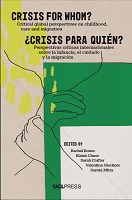Crisis for Whom?
Critical global perspectives on childhood, care, and migration
| dc.contributor.editor | Rosen, Rachel | |
| dc.contributor.editor | Chase, Elaine | |
| dc.contributor.editor | Crafter, Sarah | |
| dc.contributor.editor | Glockner, Valentina | |
| dc.contributor.editor | Mitra, Sayani | |
| dc.date.accessioned | 2023-01-06T12:17:27Z | |
| dc.date.available | 2023-01-06T12:17:27Z | |
| dc.date.issued | 2023 | |
| dc.identifier.uri | https://library.oapen.org/handle/20.500.12657/60533 | |
| dc.description.abstract | Children feature centrally in the ubiquitous narratives of ‘migration crises’. They are often depicted as essentially vulnerable and in need of special protections, or suspiciously adult-like and a threat to national borders. At the same time, many voices, experiences, and stories are rarely heard, especially about children on the move within the global South. This bilingual book, written in English and Spanish, challenges simplistic narratives to enrich perspectives and understanding. Drawing on collaborations between young (im)migrants, researchers, artists and activists, this collection asks new questions about how crises are produced, mobility is controlled, and childhood is conceptualised. Answers to these questions have profound implications for resources, infrastructures, and relationships of care. Authors offer insights from diverse global contexts, painting a rich and insightful tapestry about childhood (im)mobility. They stress that children are more than recipients of care and that the crises they face are multiple and stratifying, with long historical roots. Readers are invited to understand migration as an act of concern and love, and to attend to how the solidarities between citizens and ‘others’, adults and children, and between children, are understood and forged. | |
| dc.language | English | en_US |
| dc.subject.classification | thema EDItEUR::J Society and Social Sciences::JB Society and culture: general::JBF Social and ethical issues::JBFH Migration, immigration and emigration | en_US |
| dc.subject.classification | thema EDItEUR::5 Interest qualifiers::5P Relating to specific groups and cultures or social and cultural interests::5PB Relating to peoples: ethnic groups, indigenous peoples, cultures and other groupings of people::5PBC Relating to migrant groups / diaspora communities or peoples | en_US |
| dc.subject.classification | thema EDItEUR::J Society and Social Sciences::JB Society and culture: general::JBS Social groups, communities and identities::JBSP Age groups and generations::JBSP1 Age groups: children | en_US |
| dc.subject.classification | thema EDItEUR::J Society and Social Sciences::JH Sociology and anthropology::JHB Sociology | en_US |
| dc.subject.classification | thema EDItEUR::J Society and Social Sciences::JH Sociology and anthropology::JHM Anthropology | en_US |
| dc.subject.classification | thema EDItEUR::R Earth Sciences, Geography, Environment, Planning::RG Geography::RGC Human geography | en_US |
| dc.subject.other | migration;refugees;children;families;care politics;multidisciplinary research;multimodal outputs;mobility;(im)mobility;decolonisation | en_US |
| dc.title | Crisis for Whom? | en_US |
| dc.title.alternative | Critical global perspectives on childhood, care, and migration | en_US |
| dc.type | book | |
| oapen.abstract.otherlanguage | La niñez ocupa un lugar central en las narrativas omnipresentes de las ""crisis migratorias"". A menudo ésta es representada como esencialmente vulnerable y necesitada de protección especial, como sospechosamente parecida a los adultos, o como una amenaza para las fronteras nacionales. Al mismo tiempo, existen muchas voces, experiencias e historias que rara vez son escuchadas, especialmente aquellas que hablan sobre las infancias en movimiento dentro del Sur global. 'Este libro bilingüe, escrito en inglés y español, desafía las narrativas simplistas para enriquecer nuestra perspectivas y comprensión. Basada en colaboraciones entre jóvenes (in)migrantes, investigadores, artistas y activistas, esta colección plantea nuevas preguntas sobre cómo se producen las crisis, cómo se controla la movilidad y cómo se conceptualiza a la infancia y la niñez. Las respuestas a estas preguntas tienen profundas implicaciones para la distribución de recursos, la infraestructura y las prácticas de cuidado. Las y los autores ofrecen perspectivas que surgen de diversos contextos globales, construyendo un rico y detallado tapiz sobre la (in)movilidad infantil. Destacan que niñas y niños son mucho más que simples receptores de cuidados y que las crisis que enfrentan son múltiples y estratificadas, con profundas raíces históricas. Se invita a las/os lectoras/es a entender la migración como un acto de concientización y amor, y a poner atención en cómo se entienden y forjan las solidaridades entre ciudadanos y aquellos que son percibidos como “otros”; entre adultos y niñas/os, y entre las/os niñas/os mismas/os. | en_US |
| oapen.identifier.doi | 10.14324/111.9781800080782 | en_US |
| oapen.relation.isPublishedBy | df73bf94-b818-494c-a8dd-6775b0573bc2 | en_US |
| oapen.relation.isbn | 9781800080799 | en_US |
| oapen.relation.isbn | 9781800080805 | en_US |
| oapen.relation.isbn | 9781800080812 | en_US |
| oapen.relation.isbn | 9781800080829 | en_US |
| oapen.pages | 523 | en_US |
| oapen.place.publication | London | en_US |

